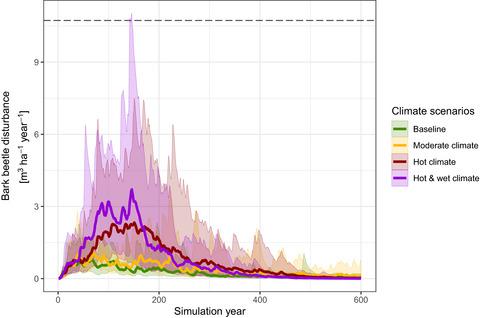Our official English website, www.x-mol.net, welcomes your
feedback! (Note: you will need to create a separate account there.)
Do bark beetle outbreaks amplify or dampen future bark beetle disturbances in Central Europe?
Journal of Ecology ( IF 5.3 ) Pub Date : 2020-09-05 , DOI: 10.1111/1365-2745.13502 Andreas Sommerfeld 1 , Werner Rammer 1, 2 , Marco Heurich 3, 4 , Torben Hilmers 5 , Jörg Müller 3, 6 , Rupert Seidl 1, 2, 7
中文翻译:

树皮甲虫的爆发会加剧还是抑制中欧未来的树皮甲虫干扰?
更新日期:2020-09-05
Journal of Ecology ( IF 5.3 ) Pub Date : 2020-09-05 , DOI: 10.1111/1365-2745.13502 Andreas Sommerfeld 1 , Werner Rammer 1, 2 , Marco Heurich 3, 4 , Torben Hilmers 5 , Jörg Müller 3, 6 , Rupert Seidl 1, 2, 7
Affiliation

|
- Bark beetle outbreaks have intensified in many forests around the globe in recent years. Yet, the legacy of these disturbances for future forest development remains unclear. Bark beetle disturbances are expected to increase further because of climate change. Consequently, feedbacks within the disturbance regime are of growing interest, for example, whether bark beetle outbreaks are amplifying future bark beetle activity (through the initiation of an even‐aged cohort of trees) or dampening it (through increased structural and compositional diversity).
- We studied bark beetle–vegetation–climate interactions in the Bavarian Forest National Park (Germany), an area characterised by unprecedented bark beetle activity in the recent past. We simulated the effect of future bark beetle outbreaks on forest structure and composition and analysed how disturbance‐mediated forest dynamics influence future bark beetle activity under different scenarios of climate change. We used process‐based simulation modelling in combination with machine learning to disentangle the long‐term interactions between vegetation, climate and bark beetles at the landscape scale.
- Disturbances by the European spruce bark beetle were strongly amplified by climate change, increasing between 59% and 221% compared to reference climate. Bark beetle outbreaks reduced the dominance of Norway spruce (Picea abies (L.) Karst.) on the landscape, increasing compositional diversity. Disturbances decreased structural diversity within stands (α diversity) and increased structural diversity between stands (β diversity). Overall, disturbance‐mediated changes in forest structure and composition dampened future disturbance activity (a reduction of up to −67%), but were not able to fully compensate for the amplifying effect of climate change.
- Synthesis. Our findings indicate that the recent disturbance episode at the Bavarian Forest National Park was caused by a convergence of highly susceptible forest structures with climatic conditions favourable for bark beetle outbreaks. While future climate is increasingly conducive to massive outbreaks, the emerging landscape structure is less and less likely to support them. This study improves our understanding of the long‐term legacies of ongoing bark beetle disturbances in Central Europe. It indicates that increased diversity provides an important dampening feedback, and suggests that preventing disturbances or homogenizing post‐disturbance forests could elevate the future susceptibility to large‐scale bark beetle outbreaks.
中文翻译:

树皮甲虫的爆发会加剧还是抑制中欧未来的树皮甲虫干扰?
近年来,全球许多森林的树皮甲虫爆发加剧。然而,这些干扰对未来森林发展的影响仍不清楚。由于气候变化,树皮甲虫的干扰预计将进一步增加。因此,干扰机制内的反馈越来越引起人们的兴趣,例如,树皮甲虫的爆发是否会放大未来树皮甲虫的活动(通过启动同龄树木群)或抑制它(通过增加结构和成分多样性)。
我们研究了巴伐利亚森林国家公园(德国)的树皮甲虫-植被-气候相互作用,该地区最近出现了前所未有的树皮甲虫活动。我们模拟了未来树皮甲虫爆发对森林结构和组成的影响,并分析了干扰介导的森林动态如何影响不同气候变化情景下的未来树皮甲虫活动。我们使用基于过程的模拟建模与机器学习相结合,在景观尺度上理清植被、气候和树皮甲虫之间的长期相互作用。
气候变化极大地加剧了欧洲云杉树皮甲虫的干扰,与参考气候相比增加了 59% 至 221%。树皮甲虫的爆发减少了挪威云杉( Picea abies (L.) Karst.)在景观中的主导地位,增加了成分多样性。干扰降低了林分内的结构多样性( α多样性),增加了林分之间的结构多样性( β多样性)。总体而言,干扰介导的森林结构和组成的变化抑制了未来的干扰活动(减少高达-67%),但无法完全补偿气候变化的放大效应。
合成。我们的研究结果表明,巴伐利亚森林国家公园最近发生的干扰事件是由高度易受影响的森林结构与有利于树皮甲虫爆发的气候条件共同造成的。虽然未来的气候越来越有利于大规模爆发,但新兴的景观结构越来越不可能支持它们。这项研究提高了我们对中欧持续的树皮甲虫干扰的长期影响的了解。它表明多样性的增加提供了重要的抑制反馈,并表明防止干扰或使干扰后森林均质化可能会提高未来对大规模树皮甲虫爆发的敏感性。











































 京公网安备 11010802027423号
京公网安备 11010802027423号